Tina Manandhar. 2014. ‘Digu pūjā: lineage god worship. A cultural study of the Kathmandu city’. PhD diss., Tribhuvan University. 238 pp., 29 illustrations. [repo – NB: is currently misconfigured] [PDF]

Luigi, Rogora. 2015-2016. ‘La Luce Nella Valle: Lo Svayambhūpurāṇa nel Buddhismo Nepālese’. Università degli Studi di Milano, Facoltà di Studi Umanistici. Corso di Laurea Triennale in Lettere. iv+167 pp. [academia.edu]
Note: Contains an annotated Italian translation of Svayambhūdharmadhātusamutpattinidānakathā 1.1–63.
Feichtinger, Walter. 2011. Rituelle Pluralität und Performanz. Das Newar Festival Nyakū Jātrā Matayā in Pāṭan, Nepal. Diplomarbeit (Mag. Phil.), University of Vienna. Fakultät für Sozialwissenschaften. URN: urn:nbn:at:at-ubw:1-29510.85611.848460-1. [PDF]
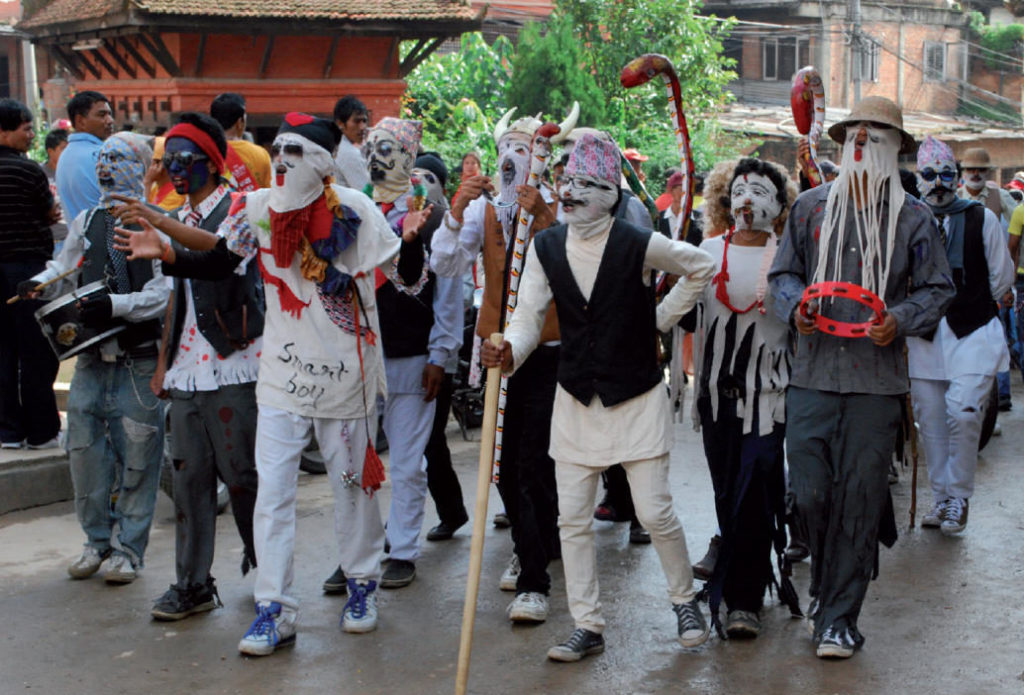
Abstract: This diploma thesis is about the plural ritual praxis of a religious festival of the Newars in the city of Pāṭan, within the Kathmandu Valley in Nepal. The Nyakū Jātrā Matayā serves as a stage for the living and dead, gods and demons, as well as the beliefs of two religious systems and a globalized society that is at the same time deep-rooted in tradition. Continue reading “Feichtinger (2011), Rituelle Pluralität und Performanz [Nyakū Jātrā Matayā]”
On April 25, 2015, just before midday local time, the Nepalese Himalayas was struck by an earthquake of magnitude ≥ 7.8. Its epicentral region was located about 80km west of Kathmandu, but the many aftershocks have been clustered around the Valley, shifting an entire region. At least ten thousand lives were lost or injured as a result. This horrific calamity was not caused by divine retribution, but rather by collisions occurring, with some predictability, between the Indian and Eurasian tectonic plates. Several M ≥ 5 aftershocks are expected, with a greater than 50% chance of an M ≥ 6 aftershock, in the coming months (Source: USGS).
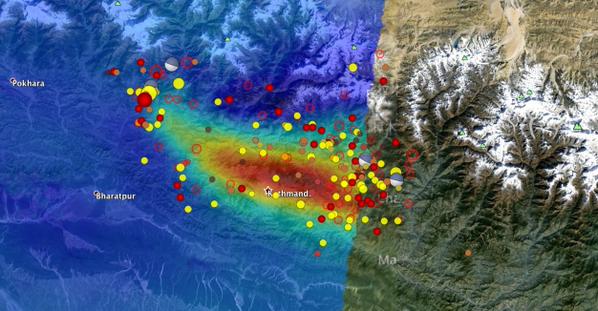
Such widely felt effects, together with the increasing pervasion of social media, are generating an unprecedented flow of data. Making sense of it is difficult for people in the midst of the crisis, let alone those on the outside — though there are some worthy efforts (*). Many call for more aid, but some say there is too much. On live television, it seems to be business as usual in the Kathmandu Valley. However, the normality orchestrated on TV reveals nothing of the disruptions likely to come: critical shortages of manpower, water, fuel and electricity, failures of agriculture and transport, debilitated families, missionary predation, ever-growing dependence on foreigners.
The situation in the Valley — since it’s what I know, it’s the part I can assess — now seems to be as follows. In the Durbar Square of Lalitpur, the Jagannarayan and Hari Shankar temples have fully collapsed. Hiraṇyavarṇa-mahāvihāra, the Golden Temple, is undamaged. There is widespread damage in Bungamati, with Amarāvati-mahāvihāra mandir laid waste. The chariot of Karuṇāmaya (‘Macchendranath’), now on its twelve-year yātrā, has been hit. In Kathmandu Durbar square, Kasthamandap, Maju Dega, Kam Dev temple and Trailokya Mohan Narayan temple were destroyed; the Kumari House stands unaffected. Kalmochan temple at Thapathali and Bhimsen Tower, a.k.a. Dharahara, have fallen down. The Swayambhu caitya has not been obviously affected, though some surrounding buildings, including the Pratappur temple, are shattered. Although a hairline crack has appeared in the Bodhnath stūpa it remains intact, apart from a collapsed stūpa on its periphery (misleadingly photographed in front of the main structure).
The old cities of Bhaktapur, Sankhu, Kirtipur and Khokana have suffered severe damage and loss of life. Beyond the Valley, in Gorkha, Sindhupalchowk and Nuwakot, whole villages have been wiped out, and reportedly, hundreds of thousands are affected in the Tibet Autonomous Region. It looks like the communities at these places will receive some aid from outside, sooner or later. Whether it arrives in good time, reaches the people who need it, is usable, makes things better rather than worse — or is needed at all — are altogether different questions.
Today nobody knows how much is being stolen from heritage sites. While UNESCO has funds to hire security, and jurisdiction over the entire Valley, the Kathmandu office says it can only work on its database. Fortunately, the job is somehow getting done. The false opposition ‘protect lives, not buildings’ is also getting a lot of airtime. Buildings are there to improve lives (unless built in a failing state). That’s why the displaced people who shivered under tarpaulins for a while have gone back to their homes as fast as they can, in spite of the risks.
The proposition that traditional spaces merely “serve as an anchor for aspiration and memory” and have nothing to do with livelihoods, shelter, storage, commerce, discourse, traffic, and the experience of pleasure and meaning is very mistaken. This damning with faint praise is no ordinary lapse of judgment; the Newars’ spaces seem to incite real unease among those who don’t belong there. This shows that they work as intended, and that their value comprises far more than the sum of their parts. Even in times of weakness, the Kathmandu Valley’s precious urban landscape can resist the neuroses projected onto it from outside. Nonetheless,this priceless quality won’t continue of its own accord. It needs intelligence, attention and work. That is how lives are renewed.
Niraj Dangol. ‘Sana Guthi and the Newars: impacts of modernization on traditional social organizations’. Universitetet i Tromsø: Mastergradsoppgave, 2010. [URI / PDF]
“Guthi, the traditional social organization, can be classified into various categories according to their functionalities among which, Sana Guthi is regarded most popular and the important one. Among the various functions performed by the Sana Guthi, death rituals are regarded extremely important from religious as well as social point of view. […] In this study, two of such festivals conducted by Shree Bhairabnath Ta: Guthi of Panga have been studied in details.”
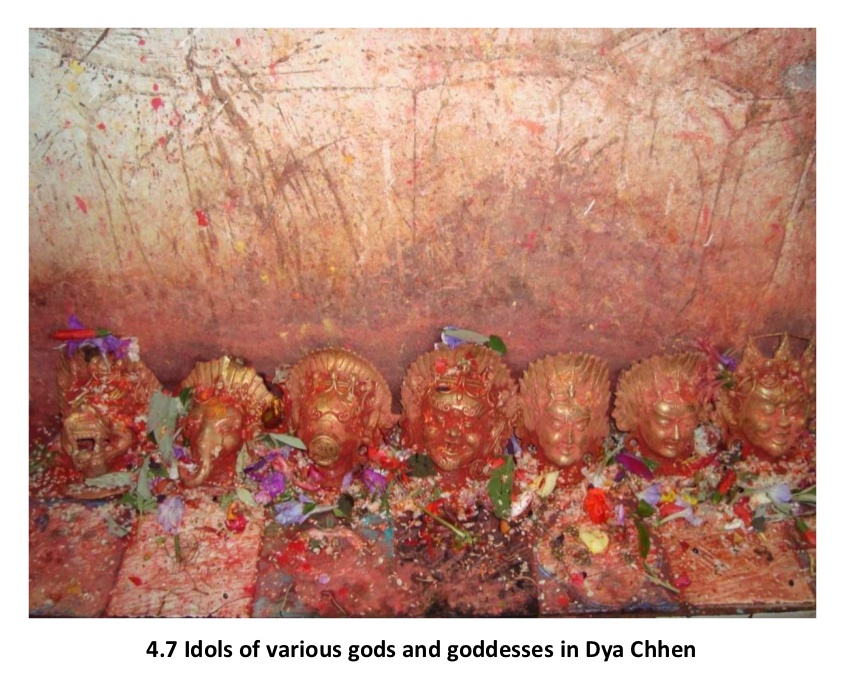
Paṇḍita Kavirāja Saddharmarāja Bajrācārya Śāstrī (tr.) Ārya Mañjuśrī Nāmasaṅgīti: advayaparamārtha nāmasaṅgīti. Ācārya Vilāsavajra kṛta Nāmamantrārthaavalokinī Ārya Mañjuśrī Nāmasaṅgītiyāgu ṭīkāyā lidhaṃsāy, ṭippaṇī va bhāvārthasahita Nepālabhāṣāy saṅkṣipta anuvāda. Lalitapura: Rāmeśa Maharjana saparivāra, VS 2068 [2011 CE]. na+320 pp.
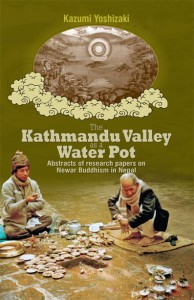 Long-time readers might remember this – now in print:
Long-time readers might remember this – now in print:
Yoshizaki, Kazumi (吉崎一美). The Kathmandu Valley as a Water Pot: Abstracts of research papers on Newar Buddhism in Nepal. Kathmandu: Vajra Books, 2012. 172 pp. ISBN: 9937506743. EAN: 9789937506748. USD$12.95. [official site]
[See Yoshizaki (1991), (1994a), (1994b), (1995), (1996a), (1996b), (1996c), (1997a), (1997b), (1997c), (1998a), (1998b), (1998c), (1998d), (1999), (2001), (2002a), (2002b), (2003a), (2003b), (2005a), (2005b), (2005c), (2007a) and several others.]
Refer to: Anshuman Pandey, ‘N4184 Proposal to Encode the Newar Script in ISO/IEC 10646’, February 29, 2012 [PDF]. Previous discussion: here.
The name ‘Newar’ is preferable simply because most other options can be ruled out. ‘Nepalese’ is untenable, because it falsely implies a one-to-one relationship with the present-day nation-state, even though it is accurate within a certain (historically earlier) context. ‘Newari’ is a (now deprecated) name for the language – not the script, nor anything else; ‘Nevārī’ is quite meaningless, except to some Indologists.
The proposal, as I understand it, indeed deals with the Pracalita script, but has enough hooks to allow unification with proposals for other Newar scripts, such as Bhujiṅmola – hence ‘Newar’. (NB: It is not yet clear whether unification with Rañjanā – which is, strictly speaking, Indo-Nepalese, and which has a user base that includes many non-Newars, such as Tibetans – is feasible. In any case, much of the present and previous discussion about the Pracalita script is also applicable to Rañjanā.)
11442 NEWAR FINAL ANUSVARA: Although this mark originates with the m-virāma mark used by East Indian scribes, in Nepal it has multivalent significance and in many contexts has nothing to do with nasalization (often being interchangeable with 1144B NEWAR GAP FILLER). Recommendation: Minimise phonetic/semantic description in favour of graphic description – maybe NEWAR SEMICOLON for want of a better term. Classify under Punctuation or Various Signs.
11443 NEWAR SIDDHI = शुभचिं (Shrestha NS 1132:21). There is no uniform name for this mark in Newar (esp. not the neologism bhiṃciṃ), nor is siddhi/añji recommended (not just because this designation is unknown in Nepal, but because usage may also vary; confusion with NEWAR OM is common). Recommendation: NEWAR AUSPICIOUSNESS MARK or similar.
11448 NEWAR COMMA = अर्धविराम (Shrestha NS 1132:24).
11449 NEWAR DOUBLE COMMA: I now think this mark can be represented with two adjacent NEWAR COMMAs. Its usual behaviour of stacking diagonally (see Fig.3) rather than horizontally should however be specified. Recommendation: Remove from the repertoire.
1144B NEWAR HIGH SPACING DOT = अल्पविराम (ibid.).
1144C NEWAR ABBREVIATION SIGN CIRCLE = संक्षेपीकरण यानाः च्वयातःगु थासय् थुगु चिं (ibid.).
1145A NEWAR FLOWER = स्वांथें ज्याःगु चिं (ibid.).
1145C NEWAR PLACEHOLDER MARK is the line-width equivalent of the NEWAR GAP FILLER (see below). Recommendation: Change name to NEWAR LINE FILLER MARK.
Following comments on earlier drafts of N4184, especially those of Kashinath Tamot, it should be clarified that the primary function of 1144B NEWAR GAP FILLER is not that of indicating a break in a word (as per the previous name SANDHI MARK), but rather of filling space up to the end of a line margin. (A hyphen indeed performs a space-filling operation as well as functioning as a word-breaking mark. However, I suggest that ‘hyphenation’ be dropped from the formal description of this mark to avoid confusion.)
The purpose of this mark has been obvious enough to specialists – recently see, e.g. Ishida (2011:ix), where it is called a ‘line-filler character’, Zeilenfüllzeichen. (In fact, this mark does not fill a line – this is the function of 1145C NEWAR PLACEHOLDER MARK; rather, it fills a space of less than one full glyph-width at the end of a margin, not necessarily the end of a line.) Nonetheless, it is easily seen that the mark could be confused with, e.g., a visarga, daṇḍa or similar. In earlier discussion on the proposal, its purpose has remained unclear to the user community, perhaps due to its unstable shape. Significantly, the NEWAR GAP FILLER MARK changes according to the width of the glyph. Its behaviour may be represented as follows:
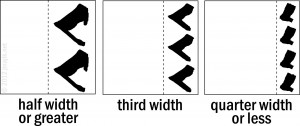
Variations in this mark may therefore be regarded as contextual alternatives, rather than separate code points. I suggest, as per the diagram, that no more than three variants need be represented; although the glyph could conceivably incorporate four or more variations (e.g., five vertically stacked dots, at 20% character width), this is probably excessive.
Recommendation: It may be implemented as one code point with contextual alternates, or 3 or more code points corresponding to each quantum of width.
Several glyphs may be alternatively represented with swash forms, created by extending elements of the glyph into surrounding white space. These forms do not require dedicated representation in an encoded repertoire; however, they should be included in any full description of Indo-Newar scribal culture, and font designers might want to incorporate them. Swash forms are often contextually invoked: they are used at the top line of a block of text (upward extension), but may also be seen on the bottom line (downward extension), and even more rarely at the right and left margins, and within interlinear white space. An example:

Characters routinely represented as swash forms include:
11432 NEWAR VOWEL SIGN U, 11433 NEWAR VOWEL SIGN UU, 11439 NEWAR VOWEL SIGN AI, 1143B NEWAR VOWEL SIGN AU, (superscribed) 11428 NEWAR LETTER RA, 1143D NEWAR SIGN CANDRABINDU, 1143E NEWAR SIGN ANUSVARA – upward extension;11402 NEWAR LETTER I, 11403 NEWAR LETTER II, (subscribed) 11417 NEWAR LETTER NYA, 1141D NEWAR LETTER TA, 11423 NEWAR LETTER PHA, 11425 NEWAR LETTER BHA, 11429 NEWAR LETTER LA, 1142D NEWAR LETTER SA, 1142E NEWAR LETTER HA, 1143C NEWAR SIGN VIRAMA – downward extension.The following changes to standard forms are recommended – see glyphs highlighted in Fig.3, in which all glyphs have been redrawn from scratch to accord with common scribal practice. The most widespread change is that the headstroke no longer extends past the right descender (which is inconsistent with almost all scribal practice). Standard forms for VOCALIC R, VOCALIC RR, GA, SHA, dependent VOWEL SIGN II, VOCALIC R, VOCALIC RR as well as *VOCALIC L, VOCALIC LL (these should certainly be specified and named) should be altered accordingly. DIGIT ONE should also be changed in order to avoid confusion with SIDDHI.

5.2 Letter-Numerals: “There are at least 27 such Newar ‘letter numerals’… It may be possible to unify Newar letter-numbers with corresponding Brahmi characters.” The issue here, as far as I can see, is: which letter-numeral conjuncts differ from non-numeral conjuncts of the same letters (all differences should be specified). To put it another way: which letter-numeral conjuncts uniquely signify letter numerals, if any? Perhaps our European colleagues, with their extensive access to funding, institutional support and manuscript sources, could clarify the matter. (Don’t worry, we won’t hold our breath.)
5.3 “Should editorial marks be encoded on a per script basis or would be it reasonable to unify such marks in a pan-Indic block?” (Pandey 2012:13). Out of our hands, but if they aren’t unified, they should be included in the Newar block.
[rev 0.1: 2012/06/19]
Gudrun Bühnemann. The Life of the Buddha: Buddhist and Śaiva Iconography and Visual Narratives in Artists’ Sketchbooks from Nepal. By Gudrun Bühnemann, with Transliterations and Translations from the Newari by Kashinath Tamot. Lumbini: Lumbini International Research Institute, 2012. ISBN 9789937553049, 204 pp. USD$50. [available from Vajra Books]
This book describes, analyses and reproduces line drawings from two manuscripts and a related section from a third manuscript. These are: 1) Manuscript M.82.169.2, preserved in the Los Angeles County Museum of Art (circa late nineteenth century) 2) Manuscript 82.242.1-24, preserved in the Newark Museum (from the later part of the twentieth century) and 3) A section from manuscript 440 in the private collection of Ian Alsop, Santa Fe, New Mexico (early twentieth century). The line drawings depict Hindu/Śaiva and Buddhist deities and themes, but the Buddhist material is predominant, as one would expect in artists’ sketchbooks from Patan. […]